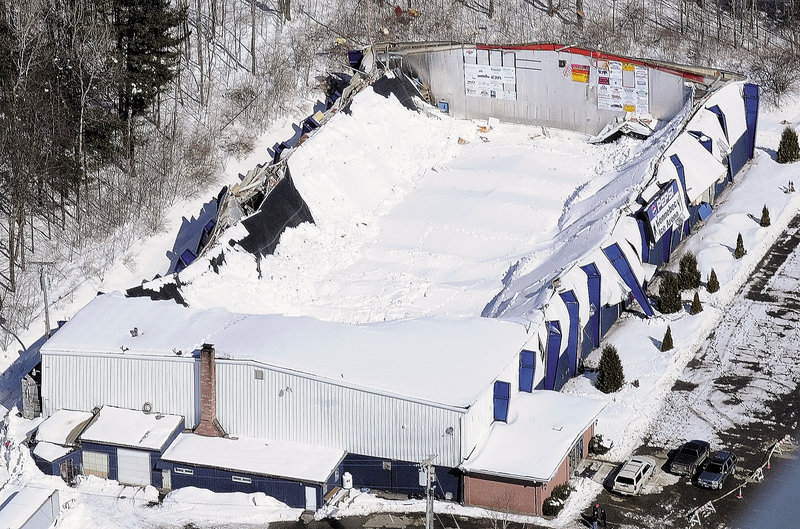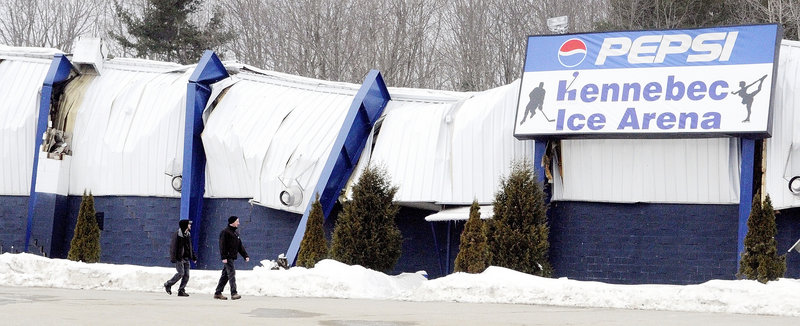Tony LaPlante remembers his first time at Kennebec Ice Arena.
“I skated there the week it opened,” he said. “I think I was 9 years old.”
LaPlante went on to star for the Cony High hockey team that played at KIA and later returned to coach at his alma mater. He skated there just a couple of months ago in a men’s pickup game.
“Some of the best memories of my life were inside that building,” LaPlante said. “It’s really sad to see what happened.”
The Kennebec Ice Arena roof collapsed March 2, causing irreparable damage to the building that was built in 1973 by a group of local businessmen who wanted a nearby rink where their kids could skate and play hockey.
Over the past 38 years, the building, on the Whitten Road in Hallowell, has played host to past and present National Hockey League stars.
“(The Bruins) used to come down every other year,” former rink manager Al Globensky said. “It benefited the youth program.”
Terry O’Reilly, Rick Middleton, Lyndon Byers, Gary Doak and other former Bruins graced the KIA ice, always against local talent and in front of a packed house. Eric Weinrich, who grew up in Gardiner and got his start at KIA, eventually made it to the NHL, where he had more than 1,000 games as a defenseman for a number of teams.
High school hockey formed the heart and soul of the arena, particularly in the 1970s through the mid-1980s whenever teams from Cony, Gardiner or Winslow got together.
“Driving up from Gardiner on the bus (you would see) cars up and down the Whitten Road,” former Gardiner goalie and coach Chris Buck said. “In the locker room you could hear the crowd. Butterflies would be churning and you’d start sweating then.”
Globensky recalls setting up a buffer zone in the stands during Cony-Gardiner games so the fans wouldn’t infringe on one another.
“I think we had to have six cops on for Cony-Gardiner,” he said.
Winslow was no less a team in this rivalry. The Black Raiders called KIA their home ice and won their Class B state championships there, beating Cony for the title in 1978.
“It was our home arena for six or seven years,” said former coach Harold Violette, who won six state titles in 17 years as coach. “It was a tremendous atmosphere for a game. Usually it was a very raucous crowd. People were very passionate.”
Violette calls Kennebec Ice Arena the birthplace of Class B hockey, which played its first championship game there in 1977. Most of those involved Winslow, Gardiner or Cony. Gardiner won three titles and although Cony didn’t win any, the Rams played in six championship games, losing five to Winslow or Gardiner.
“One year it got so big we played at Colby (College),” Violette said of a playoff game against Gardiner. “It was a sold- out arena.”
As competitive as the games were, Violette said there was always cooperation among the coaches. In those days, Meylon Kenney was at Cony and Norm Gagne at Gardiner.
“If one team was three or four goals ahead, we’d look at each other and each throw out a third line,” Violette said. “We’d dress 21 or 22 kids because there was a chance they’d play.”
And as contentious as those games could get, the animosity never carried beyond the ice.
“We grew playing with all the kids from Gardiner and they’re our friends,” LaPlante said.
Skating instruction
Figure skating and basic skills instruction coincided with the rise of hockey at KIA and has been one its most prominent activities. What began as the Kennebec Skating Club later merged with a club from Penobscot Valley and became the Skating Club of Maine.
The club enjoys a national reputation thanks in part to its founder, Priscilla Millier of Winthrop, and those who taught skaters like Polly Hodgkins, also from Winthrop.
“Outside of Peter Prescott and Rosie Santerre, I’m probably the oldest associated person (with KIA),” Hogdkins said.
Hodgkins still teaches skating four hours a week but when she ran the program in the 1980s, she taught as many as eight hours a day during the summer.
“I am an ice dance specialist but I’ve been teaching basic skills since their doors opened,” Hodgkins said.
Among the ice dancers Hodgkins taught were John Millier, Priscilla’s son, and Amy Webster, who went on to win a junior national title in ice dancing.
“We’ve had several kids who went on to nationals,” said Hodgkins, mentioning Betsy Davidson of Hallowell, Kristen Andrews of Yarmouth and Jessie Valentine of Greene.
Unlike most rinks in the state, KIA stayed open year-round, which afforded the summer months to figure skaters and adult hockey leagues.
The skating club would put on at least one annual show, usually in the spring. This past year the club put on a show during the summer to accommodate a guest appearance by former world champion Todd Eldredge. The club also hosted two international competitions by Skate America in Portland in 1986 and 1988.
Millier said the club had well over 100 members at its peak.
“We’ve had some nice, nice athletes,” Millier said. “Kennebec Ice Arena has been wonderful. We’re just so fortunate to have had a rink manager and owner who supported us.”
Added Hodgkins: “They had to take the rink out from under me to stop me from teaching,”
Youth hockey
Peter Prescott and some of his friends opened an office a year before the rink was built to help get youth hockey off the ground.
“There was no youth hockey in our area,” Prescott said. “Lewiston had it and Waterville had a little. We formed Kennebec Valley Youth Hockey.”
Prescott said his group had brochures printed in an effort to gain sponsors. They wound up with more sponsors than teams, 14 or 15 in all.
“They said ‘give it to the kids,’ ” Prescott said.
It didn’t take KIA teams long to get up to speed. One of the Mite (ages 8 and under) travel teams posted a record of 69-0 over two seasons. A few years later the core of that team won a national Division II title as Pee Wees (11-12 year-olds) in Buffalo, N.Y.
“It was unreal,” said Prescott, one of the team’s coaches.
Youth hockey was built from the ground up. Coaches were self-taught and passed on their knowledge to players. They also helped raise money for the programs along with the parents.
“Most of us were homegrown,” Prescott said. “We had to learn and do it. We had fund raisers for the kids at least on average once a month. We had can drives, and supper after supper after supper.”
Youth hockey peaked in the early 1990s, when some towns began to split away from Kennebec Valley Youth Hockey and formed their own organizations. Numbers began to dwindle. The house leagues, the bedrock of any rink’s youth hockey, also suffered from fewer participants.
Today, players from Kennebec Valley Youth Hockey play teams around central Maine and are in effect travel teams themselves. The actual travel teams have combined with other rinks and organizations to boost numbers.
In its heyday, Kennebec Valley Youth Hockey hosted a youth hockey group from Ponte-Rouge, Quebec, each year and would also travel there for games and to socialize with friends and parents of the other teams.
“The people were wonderful,” Prescott said. “We did it for years and years.”
Rink manager K.C. Johnson said if a kid wanted to play and couldn’t afford it, he or she got in one way or another.
“The rink did a lot to take kids off the streets,” he said. “It was a home away from home.”
Public skating, adult leagues
Public skating, on weekends and during the week, was a vital part of activities at KIA, as were the adult hockey leagues.
“In the beginning we had too many people,” Globensky said of the weekend public skating. “After awhile we had it during the week. There were certain people you could always count on. We also had (pickup hockey).”
Johnson said ice time was at such a premium when he was in high school, his coaches told him to attend public skating for an extra workout.
“It’s great cardio,” he said.
Adult leagues flourished and there were as many as 23 teams at one time. Now that number is between 12 and 14, according to Johnson, who plays himself.
“It’s always competitive, depending on who’s playing,” Johnson said. “People, when they step on the ice, take their game seriously. One of the things about men’s leagues which is cool is the camaraderie in the locker room.”
Johnson said he was surprised how many people he heard from and how many also showed up on the Whitten Road after the roof collapsed.
“It was amazing to hear what people remembered and the history they’ve had with the rink, and how much a part of their lives it was,” he said.
Send questions/comments to the editors.




Comments are no longer available on this story